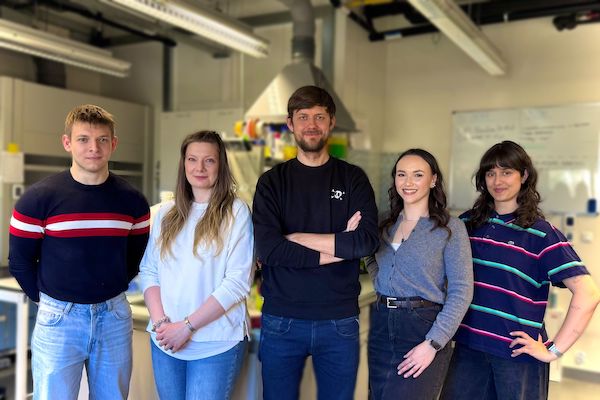Publication by a research team led by Dr. Paweł Sikorski in „Science Advances”

10 04 2025
Researchers led by Dr. Paweł Sikorski from the Faculty of Biology at the University of Warsaw have published an article in”Science Advances” titled “Effective recognition of double-stranded RNA does not require activation of cellular inflammation”. The scientists focused on the question of how cells recognize double-stranded RNA without triggering an inflammatory response.
Double-stranded RNA (dsRNA) is a molecule naturally present in human cells, but its excess usually signals a threat – such as a viral infection. Humans as all organisms have evolved complex mechanisms to detect dsRNA and initiate an immune response. Until now, it was believed that any effective cellular response to dsRNA inevitably led to inflammation. However, research conducted by a team of scientists led by Dr. Paweł Sikorski at the University of Warsaw, in collaboration with the Medical University of Białystok and the Technical University of Munich, has shown that cells can respond to dsRNA without triggering an inflammatory reaction. The members of the research team involved in the project from the Epitranscriptomics Laboratory at the Faculty of Biology, University of Warsaw, were: Dr. Karolina Drążkowska, M.Sc. Eng. Julia Cieślicka, M.Sc. Michał Kitowicz, and Wiktoria Szymanek.
There are two main mechanisms by which human cells respond to dsRNA. The first, dependent on RIG-I-like receptors (RLRs), leads to the activation of the MAVS protein, which results in the production of interferons and pro-inflammatory cytokines. The second, independent of this pathway, involves the PKR protein and the OAS/RNase L-based mechanism, which inhibit cell growth or degrade RNA, preventing viral spread.
“Our research has shown that these two mechanisms can function independently of each other. This means that a cell can inhibit its own growth and eliminate viral RNA without triggering a full inflammatory response. This discovery suggests that we have more subtle defense strategies that do not always require the activation of energy-consuming inflammatory processes” says Dr. Paweł Sikorski, head of the Laboratory of Epitranscriptomics at the Faculty of Biology and the Biological and Chemical Research Centre of the University of Warsaw.
Additionally, dsRNA can originate from intracellular processes, which may explain why the cellular defense system activates only those pathways that suppress cellular metabolism rather than those leading to the production of interferons and pro-inflammatory cytokines. Such metabolic suppression may give the cell time to eliminate the threat posed by the presence of dsRNA. In contrast, the activation of RLR receptors is likely aimed at quickly warning other cells in the body about a potential threat – a virus – and preparing uninfected cells to fight it. In the case of endogenously derived dsRNA, there is no need to trigger inflammation or warn neighboring cells.
Viruses attempt to evade detection by infected cells using various strategies, such as modifying their own RNA to resemble host RNA. Scientists studied the impact of three RNA modifications commonly found in humans – N6-methyladenosine (m6A), 5-methylcytosine (m5C), and pseudouridine (Ψ) – on the immunogenicity of dsRNA. They found that these modifications alone do not significantly affect dsRNA ability to trigger an immune response. Only the presence of6A weakened the OAS/RNase L-dependent pathway, likely by loosening the structure of dsRNA.
Researchers discovered that the structure of double-stranded RNA plays a crucial role in recognizing such molecules as a threat. The OAS/RNase L- and PKR-dependent pathways are activated primarily by the presence of dsRNA itself, regardless of its specific modifications. In contrast, RLR receptors, which initiate inflammation, are more sensitive to the chemical groups at the ends of dsRNA.
Interestingly, cells can recognize dsRNA even when RLR receptors are not activated. This suggests that cellular defense mechanisms are more complex than previously thought and may function selectively depending on the context of the threat.
The findings from this research have potential applications in designing new antiviral therapies and influencing the development of RNA-based technologies, such as mRNA vaccines. Since some RNA modifications can allow evasion of immune detection, they could be used to enhance the safety and effectiveness of RNA-based vaccines or drugs.
“We have demonstrated that dsRNA recognition in human cells can occur in different ways – with or without inflammation. This is an important step in understanding how our immune system works and how these mechanisms can be manipulated for therapeutic purposes” adds Dr. Paweł Sikorski.
Photo: (on the left) Michał Kitowicz, Karolina Drążkowska, Paweł Sikorski, Julia Cieślicka and Wiktoria Szymanek